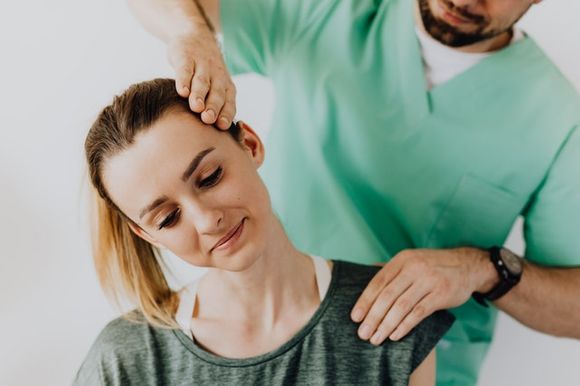Author: Silvia Marinova, PhD student in the Genomic Stability Laboratory at BAS
The article was approved by physiotherapist Georgi Peshev. The material aims to raise awareness and does not recommend self-medication.
I can almost certainly say that by currently reading this article, you are either sitting in front of the computer, or over the phone, consciously or not, very often in the wrong anatomical position.
Have you ever wondered how much of the day you spend sitting and how it affects your spine?! Or why, sitting down, we often try to alleviate our discomfort through all sorts of posture changes. In most cases, we do so unconsciously and in many cases incorrectly, which exacerbates the consequences of already excessive sitting.
This leads to bone-joint functional changes and muscle imbalance, which are due to the weakening of certain groups of muscles at the expense of excessive overstrain and shortening of others - a sure prerequisite for the appearance of pain and probable degenerative bone-joint changes over time.
In the previous article [ref.1] we mentioned this problem as part of the general harm to our health from excessive time spent in posture sitting, but undoubtedly it deserves a more thorough examination, as we will see that there is something we can do to help our body cope better with it.

Muscle dysfunction - what is it
Physical inactivity is a major cause of muscle dysfunction. Generally speaking, it is the inability of a muscle or muscle group to perform its normal functions due to a change in strength and / or endurance. This causes the body to look for ways to compensate by changing the shape and tone of adjacent muscles and muscle groups, which affects the overall postural picture. The term postural means deviation from the natural position of the body.
There is no doubt that muscle dysfunction has increased in recent decades due to the change in life to more sedentary and hectic. Studies in the field show that muscle pain has increased significantly in the last 40 years [ref.2]. All the devices that make our daily lives easier, such as cars, phones and computers, ultimately lead to our immobility.
If left untreated, this gradually causes muscle imbalance, which in turn is a prerequisite for more frequent injuries and contusions. In this and the next article, we will look at the three most common problems with proper posture caused by prolonged sitting.
Head bowed forward
The medical term for a head bowed forward is forward head posture. The forward head posture is associated with spending too much time in the wrong posture, sleeping on an excessively high pillow and with the inability of certain muscles to resist the effect of gravity.

As we explained above, over time, some muscles weaken and others shorten. In this case, the following changes are observed:
- Overload/shortening - increased muscle activity is observed in the muscles at the base of the head (subocypital muscles) and neck muscles, as they maintain the posture when we are staring at the phone or monitor, for example. Other muscles that have an increase in tone are the cervical muscles that hold on to the scapula and upper chest. These include the scapula lifter, upper trapezoidal muscle, sternocleidomastoideus and scalene muscles.
- Decreased load - in other muscles, the opposite effect is observed - decreased tone and elongation. Here we are talking about the muscles retractors of the scapula (they stabilize it) - rhomboid muscles and trapezoidal, as well as the front cervical muscles (deep cervical flexors), which are involved in pressing the chin to the neck and keeping the head in a neutral position.
Over time the listed muscle imbalances lead to joint problems in the area, spinal distortions [ref.3] (straightening of cervical lordosis), problems with the intervertebral discs, etc. They can also cause so-called cervicogenic headaches. This type of headache originates in the neck and is characterized as chronic.
Usually in the beginning the pain appears and disappears, but over time it can progress and become permanent. Often the cervicogenic headache remains misdiagnosed, since the clinical picture resembles primary types of headaches. Among the symptoms are pain originating from the back of the neck, and spreading usually from one side of the head to the forehead, pain in the shoulder and arm on the same side, limited volume of neck movements. In some cases, the pain can be on both sides ofthe head, but this is less common.
A forward head posture can also lead to:
- General stiffness - you may feel unpleasant pain on the side or back of the neck that spreads to the shoulders and upper back.
- Intense pain - it is possible that some muscle gets a spasm. It feels like acute burning pain. It is characteristic of this type of pain that it can be located very accurately in one particular place. Some positions on the head increase pain and others relieve it.
- Reduced neck mobility - due to pain and reduced muscle function, neck mobility can increase.
Is there anything you can do and what? There are a few steps you need to take:
- Correct diagnosis - the first step is to consult a specialist who will give you postural analysis and functional diagnostics. This means that they will assess which muscles are affected and how.
- Kinesitherapy - this part also includes the involvement of a specialist. They will choose the right manual techniques with which to relax the tight muscles and activate the relaxed ones. They will also guide you to appropriate exercises according to individual needs.
- Exercises - the next section of the article is dedicated to them.
- Ergonomics - you could strive consciously for the right posture, as well as look for ergonomic solutions for your daily life. It is also good to adjust, if necessary, the height of your pillow.
What exercises to perform to deal with forward head posture problems

Physical activity is an important part of the life of each of us and we have to try to keep our body in good shape.
Most people do not move enough and therefore often have problems with their musculoskeletal system. But this does not mean that active athletes are protected. On the contrary, quite often they work on one muscle group and neglect others. This predisposes them to injuries, and can also exacerbate problems related to irregular posture. The next few exercises are tailored specifically for working on the muscles, the dysfunction of which leads to a forward head posture.
The first group of exercises are aimed at stretching shortened and overactive muscles:
- Stretching the sternocleidomastoideus - stand in a seated position with a neutral position on the head. Twist it in one direction and then move it back so that you feel stretching. Hold for about 10 deep breaths and exhalations. Repeat to the other side.
- Stretching the front scalenes - the exercise is similar to the above described. This time you tilt the head to the side (ear to shoulder), then twist in the same direction and raise the chin to the ceiling. Repeat on the other side and again hold for about 10 breathing loops.
- Stretching the subocypital muscles - cross the fingers and place them in the back of the head. Push the head forward and down until you feel stretching and hold. To relax this muscle group you can also apply self-massage techniques with your hands or a tennis ball.
- Stretching the upper trapezius muscle - tilt the head in one direction and gently pull it to the shoulder with your hand. Hold about 30 seconds.
The second group of exercises have the opposite effect and are aimed at increasing the muscle strength of weakened muscles. Some of them are for strengthening the stabilizers of the scapula [ref.4] - here are also exercises for the middle trapezoidal and diamond muscles.
- Lie on your stomach, take the chin to the neck and lift the head slightly. The position of the spine is neutral. Put the hands stretched to the side (T-shaped) and lift them so that you engage the muscles between the blades. As they are raised, take them to the pelvis (I-shaped). Then return them on the way back to the starting position and do several repetitions.
- Modified plank with protraction - stand in a plank position and push the back up so that the blades expand.
The above exercises are only exemplary, but they are selected as they are easy to perform and do not take much time. It is important to consult a specialist to help you prepare a special individual exercise program and guide you to the performance mode so that you progressively improve muscle function evenly and balanced. The physiotherapist will also explain to you how to perform the exercises correctly so that you do not harm yourself.
In the next part we will proceed with the other two common problems due to incorrect sitting, namely rounded shoulders and increased front inclination of the pelvis. We'll see which muscles shorten and which weaken, and also what exercises we can do preventively.
Read the next part: Too much sitting causes functional changes to the body. What you need to know. Part 2.








